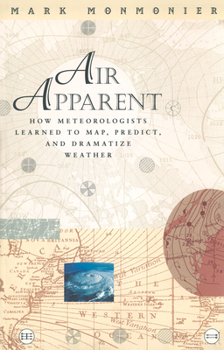Air Apparent: How Meteorologists Learned to Map, Predict, and Dramatize Weather
Select Format
Select Condition 
Book Overview
Weather maps have made our atmosphere visible, understandable, and at least moderately predictable. In Air Apparent Mark Monmonier traces debates among scientists eager to unravel the enigma of storms and global change, explains strategies for mapping the upper atmosphere and forecasting disaster, and discusses efforts to detect and control air pollution. Fascinating in its scope and detail, Air Apparent makes us take a second look at the weather map, an image that has been, and continues to be, central to our daily lives. "Clever title, rewarding book. Monmonier . . . offers here a basic course in meteorology, which he presents gracefully by means of a history of weather maps." --Scientific American "Mark Monmonier is onto a winner with Air Apparent. . . . It is good, accessible science and excellent history. . . . Read it." --Fred Pearce, New Scientist "[Air Apparent] is a superb first reading for any backyard novice of weather . . . but even the veteran forecaster or researcher will find it engaging and, in some cases, enlightening." --Joe Venuti, Bulletin of the American Meteorological Society "Monmonier is solid enough in his discussion of geographic and meteorological information to satisfy the experienced weather watcher. But even if this information were not presented in such a lively and engaging manner, it would still hook most any reader who checks the weather map every morning or who sits happily entranced through a full cycle of forecasts on the Weather Channel."--Michael Kennedy, Boston Globe
Format:Paperback
Language:English
ISBN:0226534235
ISBN13:9780226534237
Release Date:November 2000
Publisher:University of Chicago Press
Length:324 Pages
Weight:0.85 lbs.
Dimensions:0.8" x 5.5" x 8.5"
Customer Reviews
2 ratings
Good book on a neglected topic
Published by Thriftbooks.com User , 24 years ago
There have been many books about the history of maps, but few have addressed one of the types of maps that we consult most regularly: the weather map. Monmonier, a professor of geography at Syracuse University and author of several previous books, endeavors to remedy this deficiency and does so admirably.He goes back to the earliest days of investigating the weather, before telephone or telegraph when any weather map had to be put together days or more after the fact. But it gets done, even so, and when higher-speed communications are available, people are ready. He goes on to cover developments both technological and social: the advent of radar as a weather detection tool as well as the now-routine weather satellite views, but also how the weather is covered in the news, including the development of the newspaper weather map from the dull black-and-white diagrams that were once routine to the multicolored glory of USA Today's weather map. There's weather on television, too, and he spends time talking about both The Weather Channel's coverage with their many maps on a chroma-key background and how local stations cover the weather using the latest in technology, from doppler radar to the fancy, fly-through 3-D graphics that many of them seem to use these days.My personal preference would have been to learn more about the earliest days of the weather maps and how they were developed and less about the development of the glitzy modern weather reporting, but perhaps that is just me, and, considering the ubiquity of the latter, I can't fault its inclusion. Overall, it's a well-written, good read, and highly recommended for the weather fanatics among us (and I must include myself!).
A serious, well-written book
Published by Thriftbooks.com User , 24 years ago
This book uses weather maps as a central motif. It discusses issues of meteorology (although it is not really a primer on meteorology, as suggested by the Scientific American review), cartography, graphic design, and mass media. It is lightly written but well documented and intelligently illustrated. It is a great read for those who enjoy science books.






